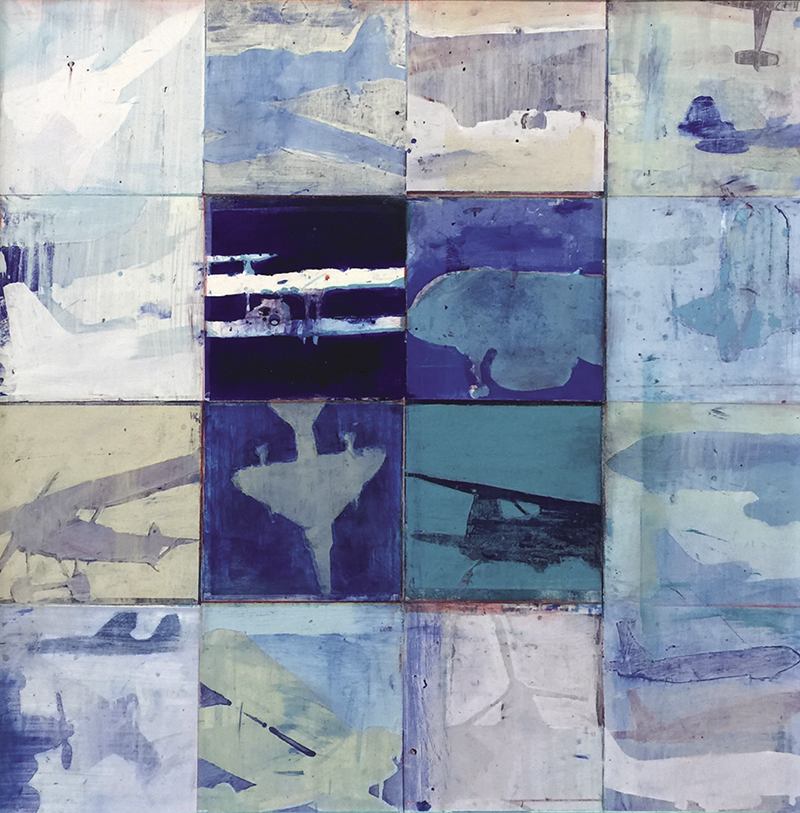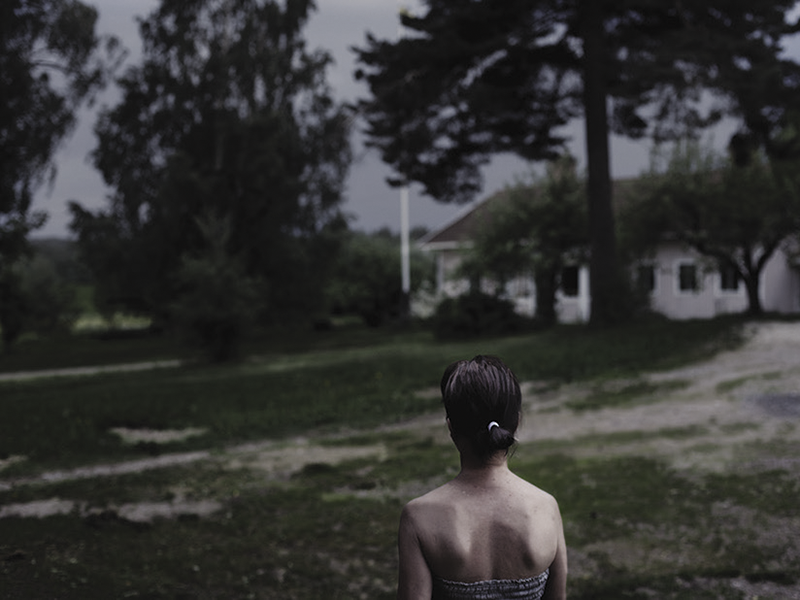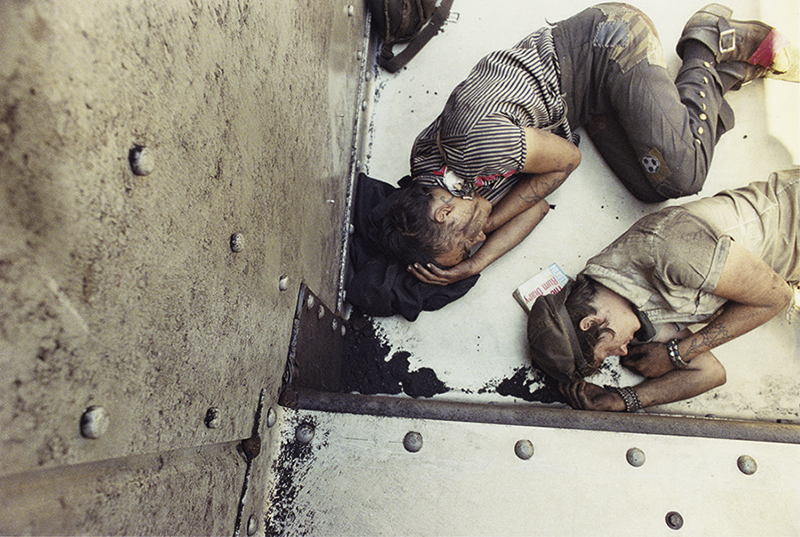
Plane Grid, by Kim Frohsin © The artist. Courtesy Andra Norris Gallery, Burlingame, California
“I am someone who can live (within reason) anywhere,” writes Aminatta Forna in her new book of essays, The Window Seat (Grove Press, $26), and we have reason to believe her. The third child of a Scottish mother and a Sierra Leonean father, raised between those countries but also in various others around the globe (her stepfather was a New Zealand diplomat; the family lived in Zambia and Thailand, and was based in Iran at the time of the 1979 revolution), she now lives outside Washington, where she is a professor at Georgetown University, but remains an inveterate traveler. Gambia, Croatia, the Shetland Islands, New Orleans, Freetown, Isfahan—the world entire unfolds through Forna’s eyes.
Indeed, the collection’s title essay is about her love of flying and her long history in airplanes—including an adventure in her twenties that some (though not this reader) may envy, practicing loops at the controls of a friend’s light aircraft. Her evocation of the ease and limitations of air travel, along with its fascinating histories (who knew about the Universal Aunts, a British organization established a century ago to assist unaccompanied minors returning from outposts of empire?), provides an apt starting point for the reflections and diverse experiences included in this volume. She turns her eye upon Santigi, a domestic worker in her stepmother’s household in Sierra Leone, whose hopes for education eventually ended in drink; she profiles a passionate (and rare) vet in Freetown, who cares for the city’s dogs; and also profiles, with equal attention, a famous Sierra Leonean chimp named Bruno. She recalls returning from boarding school to a Tehran in revolution. With her mother and brother, she visits the ancestral croft on Unst, an outer Shetland island; she tracks foxes in her London backyard, and wolves and coyotes in western Massachusetts (an interest turned to fine novelistic ends in her 2018 book Happiness); she explores the realm of sleep, or rather sleeplessness, which plagued her for years; and records her experience of the 2016 inauguration in a piece entitled “What If You Gave an Inauguration and Nobody Came.” Longer essays are interspersed with short vignettes—about a distressing childhood experience at Disney on Ice; about the Toyota Hilux, a flatbed truck that is “the vehicular equivalent of the AK-47,” “beloved of farmers, construction crews, rebel armies, warlords, Somali pirates and Afghan insurgents”; about an encounter with a peanut-butter thief at a Whole Foods in Arlington, Virginia.
A former journalist (hence her pleasingly strong tethering to facts), Forna is known chiefly as a novelist and memoirist. The Devil That Danced on the Water: A Daughter’s Quest (2002) explores the 1975 execution, in Sierra Leone, of her charismatic political-activist father Mohamed Forna, when Aminatta was just eleven years old. With this collection, she proves a compelling essayist too, her voice direct, lucid, and fearless. All the pieces are enjoyable and often surprising, even when rather slight. But the most substantial ones are memorable—even unforgettable. They deftly straddle the personal and the political. “Obama and the Renaissance Generation” provides, for a North American readership less than familiar with recent African histories, an account—inspiring and dismaying in equal measure—of the nation-building ambitions of the midcentury generation to which Obama’s Kenyan father, Kwame Anthony Appiah’s Ghanaian father, and Forna’s own father belonged. (All three men married white women—American in Obama’s case, British in the cases of Appiah and Forna.) In going to study in the United States, Obama’s father was unlike the others. Both Appiah and Forna traveled to the U.K., as did the novelist Ngũgĩ wa Thiong’o, Jomo Kenyatta (the first president of Kenya), Seretse Khama (the first president of Botswana), and Julius Nyerere (the first president of Tanzania). Forna also provides helpful political context—the legacy of British colonialism and the importance of Marxism in African liberation movements. She shows with ease just how inaccurate it is to believe that “no life could have been more the product of randomness than that of Barack Obama,” as David Maraniss wrote in his 2012 biography of the former president.
“Crossroads,” too, should be required reading. It is a meditation on Forna’s experience of moving to the United States in 2015 as a mixed-race woman in a mixed-race family of African and European heritage, informed by her Sierra Leonean legacy—which includes, of course, the slave trade (Amistad, the slave ship best known today through Steven Spielberg’s 1997 film, set out from Bunce Island, Sierra Leone). Her particular perspective sheds light on the complexity of race in the United States; the essay follows her education in a history that is not straightforwardly her own, and yet is inescapable.
Forna writes about gender too, in particular in “Power Walking.” She opens the essay with the memory of being simultaneously catcalled and subjected to racist abuse while in London in the Eighties, and proceeds to examine the purposeful intrusion of the male gaze as a condition of and a means of control over women’s experiences. As she observes, and as all women know,
The relative vulnerability of women in public spaces limits our freedom of movement and our choices. Good practise in personal safety—telling someone where we are going, allowing ourselves to be escorted home and not walking alone at night—all add up to an effective form of social control.

“Carina, a 51-year-old woman from Sweden,” by Linda Forsell. From Cause of Death: Woman, a project by Linda Forsell, Kerstin Weigl, and Karin Alfredsson © The artist
That harassment is a form of control, and hence a form of violence, is not in question for Jacqueline Rose in her brilliant new essay collection, On Violence and On Violence Against Women (Farrar, Straus and Giroux, $30):
The aim of harassment . . . is not only to control women’s bodies but also to invade their minds. . . . Harassment is always a sexual demand, but it also carries a more sinister and pathetic injunction: “You will think about me.” Like sexual abuse, to which it is affiliated, harassment brings mental life to a standstill, destroying the mind’s capacity for reverie.
Indeed, the ubiquity of violence (and, in particular, violence against women) in contemporary times is such that it may be almost unbearable to look at clearly. Statistics cited by Rose are familiar and profoundly distressing—including Catharine MacKinnon’s observation that the number of people killed on 9/11 is almost the same as the number of women murdered by men in the United States each year. But Rose argues that it is only by really looking, and by properly attending to what we see, that we stand any chance of addressing the situation:
It is the central premise of this book that violence in our time thrives on a form of mental blindness. Like a hothouse plant, it flourishes under the heady steam of its own unstoppable conviction.
Though by no means her sole subject, contemporary South Africa proves central to her enquiry—a society that has, in its history, more in common with the United States than many Americans might care to acknowledge. As she explains, “it is the place where all these forms of violence—historic, intimate—coalesce and rearrange themselves, spread throughout the social fabric and intensify.” Rose investigates violence against trans women; the intersection of race and gender; violence, disability, and—that overdetermined word—performance in the Oscar Pistorius trial; and the particular violences to which refugee women are subjected. Throughout, she returns to Hannah Arendt’s concept of “impotent bigness” (more complex than it sounds, of course, but, as a particularly male problem, essentially as it sounds), and above all, given Rose’s background and interests, to Freud, who, like Marx, may yet have an important role in contemporary discussions about how to heal our broken societies. Because, as Rose says,
For psychoanalysis, nothing perishes in the mind. As subjects we are always haunted. Struggling for a suitable analogy, Freud compared the mind to a city whose layers of history all exist simultaneously, every earlier stage persisting alongside the later stage which appears to have buried it or left it behind. Seen in this context, psychoanalysis is a counter-history, channelling what we have repressed from the past forward into a future struggling to find its own knowledge.
Rose is British, which may partly explain her attention to South Africa, but her formulation pertains as well to the United States, where today we must confront—because “reckoning with violence has to be enacted over and over again”—slavery’s bitter legacy, and the long-disregarded oppression of Native Americans. What has been repressed must be unearthed: this psychoanalytic template, Rose suggests, even as she likens it to Ubuntu philosophy, may offer a possible path forward in these times of struggle and violence.
Rose turns also to literature—to the contemporary novels of Anna Burns and Eimear McBride, the work of Toni Morrison and Han Kang. She shows a marked preference for high modernist forms (the ruptured sentences of Burns and McBride, recalling Joyce, come in for particular praise), but above all Rose seeks the expression of the abundant complexity of human experience, an event’s capacity to contain wildly contradictory elements at the same time. Ideologies often fail to describe or allow for this multiplicity: for Rose, a workable feminism must account for life as it is lived, and literature, she finds, can do this. She seeks agency for women: “The fightback is in the words, in what a mind—the life of the mind no less—can do with its own history.”
Images, too, can act as a form of resistance: a record of violence, to be sure, but also of violence transcended. Rose’s essays brought to mind, at various moments, the extensive international photography project by the Swedish photographer Linda Forsell, “Cause of Death: Woman,” which provides testimony not only to the agonizing gamut of gender-related violence—from intimate partner violence to female genital mutilation, honor killings, rape, and murder—but also, deliberately, records women as survivors, joyful and even dancing.

A photograph by Mike Brodie from his monograph A Period of Juvenile Prosperity © The artist. Courtesy Twin Palms Publishers. It appears in See/Saw by Geoff Dyer
Geoff Dyer is an idiosyncratic master of both the image and the word. In a moving tribute to John Berger, he reveals that he came to look seriously at photographs through his essays, along with those of Walter Benjamin, Roland Barthes, and Susan Sontag. Dyer, like a trained scholar (though his training has been done on the hoof), has a pantheon of originals with whom he believes most, if not all, contemporary artists are in some kind of conversation: August Sander, Walker Evans, Eugène Atget, and, of a rather later vintage, Jeff Wall.
See/Saw (Graywolf Press, $24), beautifully (but, for this greedy reader, insufficiently) illustrated, is composed of Dyer’s previously published essays on photographers and photographs, and manages to discuss not only images themselves—what they say and don’t say, how they situate themselves in relation to nature, to society, to literature—but also an exhilarating array of other subjects. He ponders architecture, musing about a Bevan Davies photograph: “This is the viewpoint of a neighbouring building. This is how a given house might appear to one of its kind . . . how these buildings might, in time, photograph themselves.” He considers the import and function of the scarecrow (in response to Peter Mitchell’s series on the same). And he reflects on porn and its relation to the work of Thomas Ruff: “At the risk of sounding like a killjoy, it bears emphasising that the anus is designed primarily for shitting.” Dyer, frank and witty, manages to be smartly entertaining. This book is fun.
Above all, of course, he makes us look at the photographers’ work anew, whether the early greats (Atget, Sander) or contemporary, less fully canonical artists such as Dayanita Singh, Doug Rickard, or Mike Brodie, whose book A Period of Juvenile Prosperity, chronicling his cross-country travel at age seventeen, was an almost accidental artwork. This gift for looking is especially striking in the book’s shorter section, “Exposures,” in which Dyer responds to individual photographs. One of these, by Kim Ludbrook, is of Oscar Pistorius in the moment he received his verdict, at the trial so richly analyzed by Jacqueline Rose. Dyer, too, evokes the athlete’s public performance: “Pistorius overflowed with emotion. His voice quavered and broke, he howled and puked, stuffed his fingers in his ears.” But ultimately, though it tells us much, Dyer rightly comments that the photograph—a portrait in profile in which Pistorius’s eyes are firmly shut, his chin raised, and the expression on his tear-stained face one of anguish, perhaps of prayer—is, pace Sontag, “worthless as evidence but dripping with meaning.”
Seen through Dyer’s eyes, many of these extraordinary photographers produce work that is “worthless as evidence,” unless it be evidence of complex interiorities, of the uneasiness of our relation to time and its passage, to memory and its erasure, to the uncertainty of longing. In 1960, Berger, from whom Dyer learned so much and who later became his friend, wrote that he asked himself, of a work of art, “Does this work help or encourage men to know and claim their social rights?” Berger was a Marxist, which shaped his aesthetic approach, whereas Dyer’s interests are more humanistic, more fluid and open-ended. The question that might best articulate his approach would be: Does this work help or encourage people to know themselves or the world in which they live? Which seems an excellent question indeed.




































































































